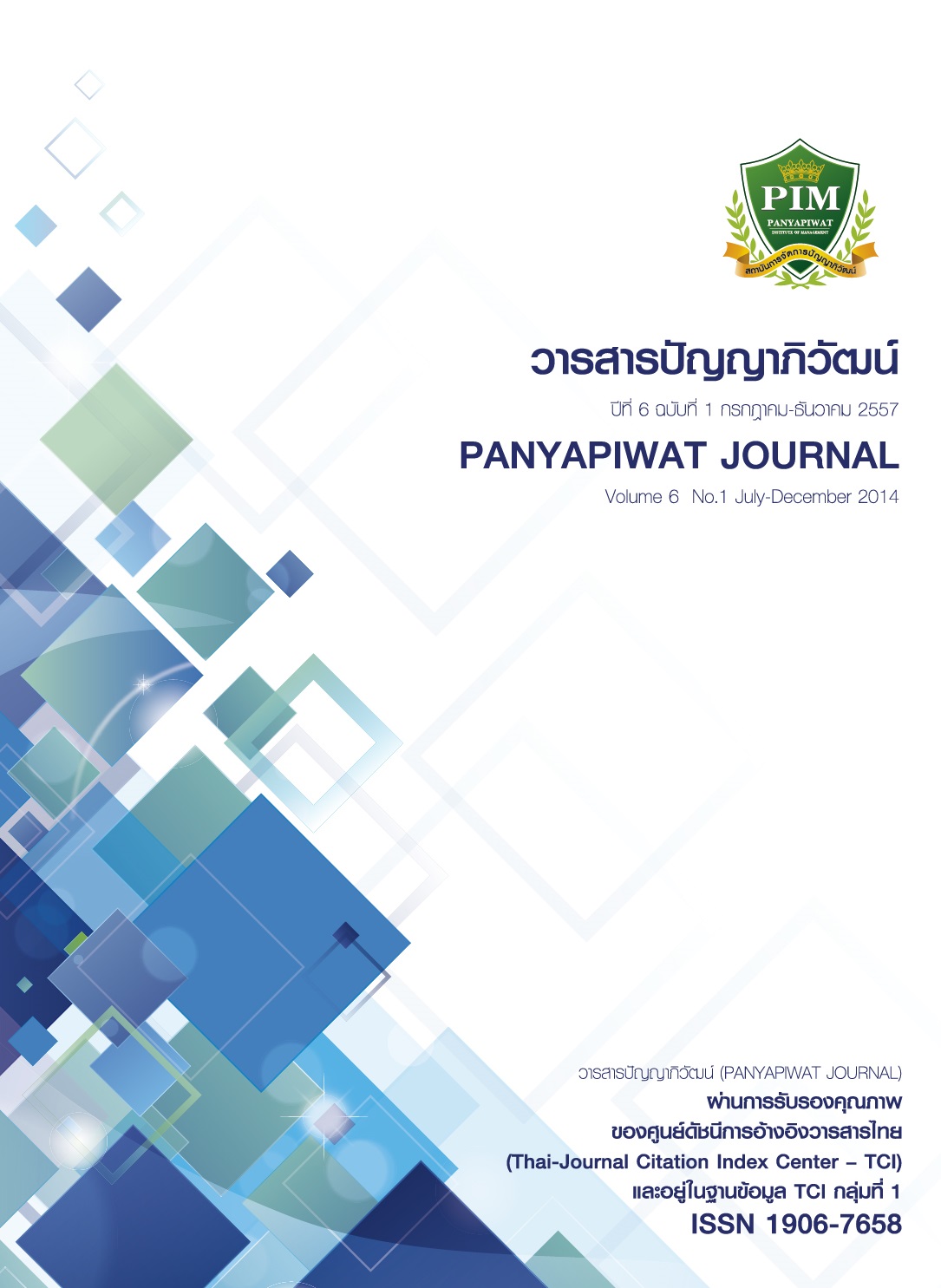การท่องเที่ยวเชิงบำเพ็ญประโยชน์กับโอการของกิจการเพื่อสังคมในเขตภาคเหนือตอนบน
Main Article Content
บทคัดย่อ
บทคัดย่อ
การท่องเที่ยวเชิงบำเพ็ญประโยชน์จัดเป็นการท่องเที่ยวรูปแบบใหม่ที่ได้รับอิทธิพลจากแนวคิดความรับผิดชอบต่อสังคม การศึกษาเรื่องนี้นำเสนอสถานการณ์ด้านอุปทาน ส่วนประสมทางการตลาด กลุ่ม ประเภทระดับความเข้มข้นของกิจกรรม และแนวทางการพัฒนาแผนการตลาดการท่องเที่ยวเชิงบำเพ็ญประโยชน์ในเขตภาคเหนือตอนบนเก็บข้อมูลด้วยวิธีการสัมภาษณ์เชิงลึกกับผู้จัดกิจกรรมในเขต 8 จังหวัดภาคเหนือตอนบน จำนวน 55 กลุ่มตัวอย่างวิเคราะห์ข้อมูลเชิงคุณภาพโดยการวิเคราะห์เชิงเนื้อหา จากผลการศึกษาพบว่า สถานการณ์การท่องเที่ยวเชิงบำเพ็ญประโยชน์ในภาคเหนือตอนบนมีแนวโน้มที่ดีมาก พบผู้จัดกิจกรรมในจังหวัดเชียงใหม่มากที่สุด รองลงมา คือ เชียงราย
และแม่ฮ่องสอน สามารถแบ่งกลุ่มผู้จัดกิจกรรมเป็น 5 กลุ่ม ได้แก่ กลุ่มผู้จัดโปรแกรม กลุ่มเจ้าของกิจกรรมกลุ่มแหล่งกิจกรรม กลุ่มองค์กรพัฒนาเอกชน และกลุ่มการท่องเที่ยวโดยชุมชน มีการจัดกิจกรรมประชาสงเคราะห์มากที่สุด ระดับการทำกิจกรรมมีตั้งแต่ระดับผิวเผินไปจนถึงระดับลึกซึ้ง ผู้จัดกิจกรรมกลุ่มที่หนึ่ง สองและสามมีแนวโน้มเติบโตขึ้น กลุ่มผู้จัดกิจกรรมส่วนใหญ่จัดเป็นกิจการเพื่อสังคมแบบที่ 1 (กิจการแบบไม่แสวงหากำไรแบบใช้คานงัด) และแบบที่ 2 (กิจการไม่แสวงหากำไรลูกผสม) ผ้จู ัดกิจกรรมแต่ละกล่มุ ต่างมีจุดแข็งจุดอ่อนแตกต่างกันไปตามลักษณะการดำเนินงานของกลุ่ม จุดแข็งที่สำคัญ ได้แก่ ประสบการณ์การทำงานด้านอาสาสมัคร การมีเครือข่ายในชุมชนและการมีพันธมิตรทั้งในและต่างประเทศ ส่วนจุดอ่อนที่ควรพัฒนา คือ ความสามารถด้านการบริหารจัดการและด้านภาษาของผู้ให้บริการ ผู้จัดกิจกรรมสองกลุ่มแรก มีการจัดส่วนประสมทางการตลาดได้ครบถ้วนที่สุด แนวทางการตลาดควรเน้นกลุ่มนักเรียนนักศึกษาในกลุ่มประเทศอาเซียน จีน ญี่ปุ่น เกาหลีใต้ อเมริกา ยุโรป และออสเตรเลีย เน้นการจัดกิจกรรมที่หลากหลาย มีคุณภาพ เน้นการสร้างภาพลักษณ์และการสร้างคุณค่าทางจิตใจ
Abstract
Volunteer tourism is considered a new form of tourism, which is influenced by the concept of social responsibility. This study presents the situations of supply side of volunteer tourism,marketing mix, clusters and types of volunteer tourism providers and guidelines for making marketing plans for volunteer tourism providers in the Upper Northern Thailand. Data were collected from 55 volunteer tourism providers in 8 provinces in the Upper North via in-depth interviews. Qualitative data were analyzed by adopting content analysis method. The study results showed that the situation of volunteer tourism in the Upper North was very positive. Most providers were found in Chiang Mai, Chiang Rai and Mae Hong Son, respectively. These providers can be classified into 5 clusters: Program organizers, Activity possessors, Activity destinations, Non-government organizations, and Community-based tourism groups. Social welfare was the most popular
activities among the providers. The level of volunteer tourism activities was varied from shallow to deep level. The customers of the first, the second and the third groups tended to be increasing. Most providers used social enterprise model 1 (Leveraged Nonprofit Ventures) and model 2 (Hybrid Nonprofit Ventures). Each cluster had different strengths and weaknesses according to their forms of operation. The significant strengths of the providers were their experiences in
volunteer work, networks in local communities and having both domestic and overseas alliances, whereas the weaknesses that need improvement were management and language capabilities of the providers. For marketing mix, the program organizers and the activity possessors were the groups that processed the complete marketing mix. The guidelines for marketing are: the providers should target their services at students from ASEAN, China, Japan, South Korea, America, Europe and Australia. The provided activities should be various with high quality. The focus should be placed on the creation of image and mental value.
Article Details
“ข้าพเจ้าและผู้เขียนร่วม (ถ้ามี) ขอรับรองว่า บทความที่เสนอมานี้ยังไม่เคยได้รับการตีพิมพ์และไม่ได้อยู่ระหว่างกระบวนการพิจารณาลงตีพิมพ์ในวารสารหรือแหล่งเผยแพร่อื่นใด ข้าพเจ้าและผู้เขียนร่วมยอมรับหลักเกณฑ์การพิจารณาต้นฉบับ ทั้งยินยอมให้กองบรรณาธิการมีสิทธิ์พิจารณาและตรวจแก้ต้นฉบับได้ตามที่เห็นสมควร พร้อมนี้ขอมอบลิขสิทธิ์บทความที่ได้รับการตีพิมพ์ให้แก่สถาบันการจัดการปัญญาภิวัฒน์หากมีการฟ้องร้องเรื่องการละเมิดลิขสิทธิ์เกี่ยวกับภาพ กราฟ ข้อความส่วนใดส่วนหนึ่งและ/หรือข้อคิดเห็นที่ปรากฏในบทความข้าพเจ้าและผู้เขียนร่วมยินยอมรับผิดชอบแต่เพียงฝ่ายเดียว”
References
การท่องเที่ยวแห่งประเทศไทย. (2552).ชู “Voluntourism”การท่องเที่ยวแนวใหม่เพื่อชุมชน. สืบค้นเมื่อ 10 มิถุนายน 2554, จาก http://www.bangkok-today.com/node/273
พงษ์จันทร์ คล้ายอุดม, ช่อลัดดา พรหมดนตรี, จุฑารัตน์ ธาราทิศ, สุกานดา เทพสุวรรณชนะ, ธนายุ ภู่วิทยาธร, เปรมกมล ปิยะทัต, สินีนาถ โชคดำเกิง และอดิศร สังข์คร. (2555). ยุทธศาสตร์ส่งเสริมการท่องเที่ยวเพื่อสร้างการเรียนรู้สําหรับนักท่องเที่ยวกลุ่มบําเพ็ญประโยชน์. ม.ป.ท. สำนักงานกองทุนสนับสนุนงานวิจัย (สกว.).
วลัยพร วาจาวุทธ, ปริศนา โพธิมณี, กันยามาศ จันทร์ทอง, พิเชฐ ยิ่งเกียรติคุณ, อมฤต เจริญพันธ์, อรกานต์ เลาหรัชตนันท์ และพิน เกษมศิริ. (2553). กิจการเพื่อสังคมนํ้าดี 50 องค์กร. กรุงเทพฯ: กรุงเทพธุรกิจ Bizbook.
ศูนย์ประสานงานการท่องเที่ยวจังหวัดกระบี่. (2550). สรุปแผนการตลาดการท่องเที่ยว ปี 2551. สืบค้นเมื่อ 10 มิถุนายน 2554, จาก http://103.28.101.10/anda/krabi/rela/Question.asp?ID=3329&CAT=tou&ggsql=
Brown, S. & Morrison, A. M. (2003). Expanding volunteer vacation participation: An exploratory study of the mini-mission concept. Tourism Recreation Research, 28: 73-82.
Callanan, M. & Thomas, S. (2005). Volunteertourism: Deconstructing volunteer activities within a dynamic environment. In Marina Novelli (editor). Niche Tourism Contemporary issues, trends and cases. (pp.183-200). Wallington: Elsevier.
Cheung, S. Michel, m. & Miller, D. (2010). Voluntourism, Give a little Gain a lot. Research Analyst Program April 8, 2010. Gorgian College. Retrieved July 3, 2011, from https://www.ecotourism.org/voluntourism-guidelines.
Edgell, D.L. (2002). The Ten P’s of Travel, Tourism and Hospitality Marketing. From Best Practices for International Tourism Development for Rural Communities. Retrieved June 12, 2012, from http://www.extension.iastate.edu/NR/rdonlyres/458279F5-112D-4B5F-AC85-F95C06BC64FA/75277/The_Ten_Ps_of_Tourism_Marketing.pdf [22 September 2011]
Elkington, J. & Hartigan, P. (2009). พลังของคนหัวรั้น. (แปลโดย สฤณี อาชวานันทกุล). กรุงเทพฯ: สำนักพิมพ์มติชน.
Handup Holidays. (2012). Meaningful Taste of Volunteering Projects for You to Choose. Retrieved October 31, 2012,from http://www.handsupholidays.com/read/Volunteer-Projects
Jasveen,Rattan, (2009). The Role Volunteer Tourism Plays in Conservation: A Case Study of the Elephant Nature Park, Chiang Mai, Thailand. (Theses Master of Arts, University of Waterloo). Electronic Theses and Dissertations(UW): [4634]. Retrieved June 10, 2014, from http://hdl.handle.net/10012/ 4817
Lovelock, C. & Wirtz, J. (2004). Services Marketing: People, Technology, Strategy. (6th Edition). New Jersey: Pearson International.
McGehee, N. G., & Santos, C. A. (2005). Social change, discourse and volunteer tourism. Annals of Tourism Research, 32(3), 760-779.
Morrison, A. (1989). Hospitality and Travel Marketing, New York: Delmar Publishers.
Tourism Authority of Thailand. (2010). TAT Fine-Tunes its 2011 Marketing Strategies in Europe.Retrieved July 3, 2011, from http://www.Tatnews.org/common/print.asp?id=5169
Voluntourism International. (2009). Voluntourism Definition. Retrieved December 12, 2010, from www.voluntourism.org
Wearing, S. (2002). Re-centering the self in volunteer tourism. In M.S. Dann (Ed.). The tourist as a metaphor of the social world (pp. 237–262). New York: CABI.
Zeithaml, V. A. & Bitner, M. J. (1996). Services Marketing. New York: McGraw-Hill.

